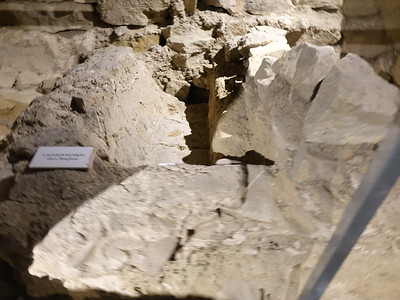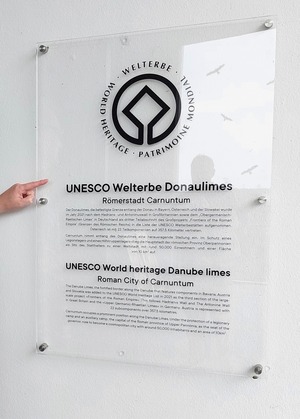Danube Limes

Frontiers of the Roman Empire – The Danube Limes (Western Segment) comprises the remains of the Roman border along the Danube River.
This 600km stretch of military installations was linked by a military road parallel to the river. The Pannonian fleet patrolled the river. A series of legionary fortresses, with thousands of soldiers each, formed its backbone. Civilian towns developed around them, and their Roman citizens introduced Roman culture (such as baths, shrines and an amphitheatre) to their surroundings.
Community Perspective: among its 75 locations, the most accessible ones are Vindobona in the center of Vienna and Porta Praetoria in Regensburg. Hubert provides a comprehensive overview of locations with visible remains in Germany, Austria and Slovakia.


Map of Danube Limes
Community Reviews
Clyde

I have visited this WHS on multiple occasions before inscription in 2013 and 2015 in Regensburg, Germany, and in 2015, 2017, 2020 in Vienna, Austria. I only had a short video of the archaeological remains of the Danube Limes in Michaelerplatz, Vienna so this time round in 2022 during a brief family reunion, I made it a point to revisit the square and take some photos for my collection.
Not that now I have spectacular photos, nor did I get much more insight by this conscious visit post-inscription. Best time to visit is around noon when the sun shines on the remains. There are a couple of information boards on both sides of the square and also on the floor near the closed off remains themselves. Small appropriately placed bronze plaques give you a better idea of what the foundations once were and their approximate date of construction. As of 2022, there still is no UNESCO WHS plaque for the Historic Centre of Vienna, nor is there one for the Danube Limes.
These kind of WHS detract from the overall value of the WH list and provide no real value added unfortunately. They are a mere tick to bolster capital cities' status or tourist centres as hotspots and are not worth visiting simply for their own merit (should they have any!).
Hubert

To sum it up right at the beginning: There is not much to see at the Danube Limes. Most of the remains are hidden under fields and meadows or have been overbuilt by later settlements and newly founded towns. There are hardly any larger visible structures. Often only some foundation walls are visible or the original remains are preserved as components of later buildings.
On several trips in the last years, since the Danube Limes appeared on the tentative list in 2015, I have visited most of the locations with visible remains. The nomination files provide detailed descriptions of each site and what you can see there. For those who don't want to go through more than a thousand pages, I will summarise my visits in this review. I will focus on the most rewarding locations and those that can easily be combined with other visits because they are within the core zone of other World Heritage Sites (Regensburg, Vienna, Wachau) or close to them.
The numbering of the multiple locations is confusing: the Unesco website lists 77 locations with consecutive IDs. In the nomination documents, locations within the same buffer zone are grouped together and listed as sublocations (a, b, c...). I specified both IDs in brackets (ID Unesco website/ID nom file).
Germany
The Danube Limes WHS starts with the remains of a thermal baths in Bad Gögging (1/1), about 50 kilometres southwest of Regensburg. Only a small part of the baths has been excavated and can be visited in the Roman Museum (located in a former church). You can combine it with a visit to the nearby Abusina fort, which is not part of the Danube Limes although it lies on the banks of the Danube. It is considered the last site of the Rhaetian Limes. I wonder what the Romans would have thought of this classification. Abusina is interesting as it is one of only a few completely excavated fortifications on the German Limes. The foundation walls have been reconstructed, so that the ground plan of the fort is visible. However, for a visit to Bad Gögging only, I would not recommend planning your itinerary according to the limited opening times of the thermal baths (weekends only).
The Porta Praetoria (7/6a) in Regensburg is certainly one of the easiest ways to tick off this WHS. It was the main gate of the Roman fortress and the original remains are clearly visible in the whitewashed façade of the later building. The site is mentioned in most guidebooks and I guess that many WH enthusiasts stood in front of it without suspecting that these few minutes would count for another WHS. If you follow the north-west and western boundaries of the historic old town, you will find more visible remains of the Roman legionary fortress (9-14/6c-h). Most of them are parts of later buildings. Clearly historical, but without the information boards you would not necessarily recognise them as Roman. Worth mentioning is location 12/6f (named document Legionslagermauer), a wall several metres high, uncovered during the construction of a multi-storey car park.
Austria
Austria has more to offer than Germany, with the best sites being in the eastern part of the Limes. In the west, only Burgus Oberranna (25/10) is worth mentioning. The remains are covered with a protective building, so pay attention to the opening hours, entrance is free. However, I would recommend a visit only if you are in the area anyway.
For those travelling by car, the section between the Wachau WHS and Vienna might be worthwhile. Free-standing parts of fortification walls and horseshoe-shaped towers can be found in Mautern (51/24a) and Zeiselmauer (61/28a und 64/28d). They have been preserved because they were incorporated into the medieval town walls. Although these remains are among the largest visible structures on the Danube Limes, it is not enough to get an idea of what an ancient Roman fort might have looked like. Traismauer is known for its Roman Gate (57/25e). But the name is misleading, in fact the building in its present appearance dates from the 17th century. The original walls from Roman times can only be seen in the lower part. In contrast, the horseshoe-shaped tower in Tulln (59/271) remained almost completely preserved up to the roof at a height of 10 metres.
Vienna is another easy tick, but the visible remains are even sparser than in Regensburg. Every visitor knows the Michaelerplatz (67/30b). In the middle of the square, a small archaeological site remained uncovered offering a glimpse of the city's history that has been preserved beneath the pavement. But you have to look closely and study the information board to identify the Roman walls next to medieval and more recent remains. There is a little more to see at Hoher Markt (High Market, 70/30e), but also below the street level. In the basement of the small Roman Museum are the remains of the tribune's houses.
And finally, Carnuntum (71/31), with 1400 hectares by far the largest of all the inscribed locations and certainly the best and most rewarding site to visit. Carnuntum was the administrative centre of the province of Pannonia. The site is interesting from an archaeological point of view because both the Roman civilian settlements and the legionary fortress have not been built over in the following centuries. The original remains comprise the ruins of a thermal bath, two amphitheatres, and the Heidentor (Heathen's Gate, photo). The archaeological park is completed by reconstructions of a city quarter with a public bath and several residential houses.
Slovakia
Of the two sites in Slovakia, I visited Gerulata, located south of Bratislava in the suburb of Rusovce. Component 72/32a comprises the foundation walls of the Roman fort, next to it an exhibition building of the Bratislava City Museum.
Hungary
At the WHC 2021, Hungary has withdrawn all its components at short notice. After long discussions the WHC decided to inscribe the remaining components in Germany, Austria and Slovakia. It is not yet clear how Hungary will proceed, if and how its locations will be included in the list. This is a pity, because Budapest in particular could contribute several sites with significant remains.
Taken together, this World Heritage Site certainly doesn't fill a visitor with enthusiasm. The visible remains are too sparse to get an idea of the structure, function and history of this frontier. Of course, visibility is not the only criterion. Modern archaeological methods such as aerial laser scanning or geophysical techniques are yielding amazing new insights. To learn more, you have to rely on museums. Along the Danube Limes there are numerous local museums, but in most cases the concept of the exhibition is outdated, boring presentations of the same finds over and over again. I have visited a few of them and in my opinion the museums in Vienna and Passau (Boiotro) are among the better ones. However, there is much room for improvement in the way this WHS is presented.
Matejicek

From the German locations included in this huge nomination, I have seen only remainings of CASTRA REGINA in Regensburg (already WHS by itself) as several parts of its fortification are still visible "in situ" (I have seen maybe two- or three-times during my occasional visits of Regensburg). The best known and at the same time the most spectacular part is PORTA PREATORIA (PHOTO), which is quite nice and impressive structure takeing into account how old this gate is. I had also oportunity to see the excavations below Niedermunster church located quite close to the gate, and parts of walls of late Roman barracks or residential villa are presented for organized tours in the underground of the church, but these are not very spectacular.
My opinion is that it does not deserve WHC status at all. Regensburg is already WHS and better preserved PORTA NIGRA in Trier has been already inscribed as well. Despite my skepticism towards this TWHS, I expect smooth after-referral inscription in 2020.
Matejicek

I saw excavated parts of VINDOBONA on Michaelerplatz in the very center of Vienna many times (PHOTO is from my last visit one gloomy day in November 2019). I am also pretty sure that I saw walls, ramparts and watchtowers dating to Roman times during my numerous visits of Wachau valley around Melk and Krems, but honestly I have no memmories on this particular point. Moreover, all the parts I saw (or potentially saw) are already included in the existing WHS Vienna and Wachau, and I would not be surprised if they are mentioned as justifications of OUV of these WHS.
Though the remainings the Roman outpost at Michaelerplatz are quite huge and nicely presented to everybody who is walking from Hofburg to Graben, I do not really understand the reason why this should be declared as WHS.
Some of us maybe remember why this extremely huge nomination was reffered during the WHC session in Azerbaijan in 2019... I gues it will be inscribed in 2020 anyway.
Els Slots

The Danube Limes was the Roman military border along the Danube. The Romans here used the river as a natural boundary: there was no boundary wall such as for example the Hadrian's Wall in northern England. This 'border' consisted of a series of defense towers, auxiliary forts and larger legionary fortresses.
The Danube Limes is nominated to become a WHS in 2019. It will be an additional site to the existing Frontiers of the Roman Empire WHS, not an extension of it. The nomination includes no fewer than 164 locations in Austria, Germany, Hungary and Slovakia. And for 2021 an extension into Bulgaria, Romania, Serbia and Croatia is already scheduled. The rationale behind this is explained as: "Unlike the Roman monuments already inscribed, the ... constructions are evidence from the edges of the Empires and reflect the adoption of Roman culture by its subject peoples."
From the sparse remains that are left of this border, I visited those in the Austrian town of Klosterneuburg. It lies half an hour drive from the airport of Vienna and thus was a nice ending of my WHS weekend in Czechia. Approaching in my rented Opel Corsa, my navigation app suddenly showed a 'ferry crossing'. Klosterneuburg lies on the 'other side' of the Danube and there is no bridge in the area. So I reluctantly took the third spot of four that the car ferry can transport - at least it gave me a feel for the width of the Danube again.
The Roman remains are located under the Klosterneuburg monastery. That monastery is located on a prominent hill in the city center, so it cannot be overlooked. I dropped my car off in a public parking and hurried to the entrance: I knew that there would be special guided tours of the Roman heritage of the monastery at 14:30 and 16:00. Exactly at 14.30 I was at the ticket counter, where I bought a ticket for 9 EUR and immediately joined the tour that had just begun.
We first walked outside of the huge monastery building to the entrance of what looked like a cellar. There is nothing left on the surface from Roman times. However, excavations have shown that the Roman camp of Arrianis (as its name probably was) was located on exactly the same grounds as the monastery. The Danube then flowed some 2 kilometers closer than is currently the case.
From March to November this year, as part of an exhibition, the Roman excavations under the cloister are also open to visitors - albeit by guided tour only. Here the guide started her explanations at a map of the former army camp. These camps or fortresses were all built according to the same model. Arrianis was not really an important camp, but fulfilled its role in border control against the barbarians on the other side of the Danube.
A further room has been turned into a lapidarium (collection of stone objects). Here you can see gravestones that were already reused by the Romans to strengthen a well. The deceased are depicted on the stones; remarkably often these are Roman men with local, Celtic women. Around the corner of the lapidarium is a unique find in a display case: a Roman military diploma. 2 fragile pieces of bronze served as a kind of identification for 'foreign' soldiers in the auxiliary troops, who had obtained Roman civil rights after 25 years of loyal service. These objects - the gravestones and the diploma - really make clear that this was a Romanized area still with many local connections and far away from Rome.
The very last space that we entered during the tour even was a few meters further down. We were now right at the foundations of the monastery. Here excavations from different periods can be seen, including underfloor heating from Roman times. All looked like stone walls to me, but fortunately signs have been added to explain from which period the particular layer of findings stems!
Zoë Sheng
Chinese-Canadian - 14-Jul-18 -

The Slovakian extension to the Roman Frontier Fortifications is minor but in my opinion highly important to the history of the Roman Empire. There are only two locations in Slovakia due to the Danube being the natural border between the Germanic and Roman forces. I went to the museum near Bratislava just across the river, far enough outside the city to actually not be Bratislava anymore but more importantly nowhere near bad traffic. The museum is called Ancient Gerulata Rusovce and features a small Roman military camp.
It has several layers of buildings from different time periods, most of them just presented by walls. The inside of the museum contains a lot of billboards for history fanatics and explains the region's fortification very well. The reason I found the camp important is that the Romans first did not cross the river due to logistic reasons but later on Emperor Antoninus no longer wanted to fight a war with the Germanic tribes and even had peace treaties.
After going through the inside for around 20 minutes you can still see the outside from a viewpoint but there is not much to see that you couldn't glance at during your walk to the museum. The museum doesn't cost much, parking should be easily found nearby (although I'm not sure why they can't add a few spaces for the museum just outside the gate), and for anyone near Bratislava I would recommend going here. I also regret driving by Iza, the second location, but at the time I didn't think it was worth going to another similar location and I think was mostly curious how come it is on the other side of the Danube.
Community Rating
- : Thomas Harold Watson Sabrina Liebehentschel
- : Rafał Kałczuga
- : BobSmithseestheworld Juropa VLabhard Christoph
- : Cutecid Eric Lurio Roman Raab Ljowers Hurrvinek Ali Zingstra
- : Hanming George Gdanski Klaus Freisinger Thibault Magnien Ralf Rotheimer Jonas Hagung Sebasfhb WalGra Bill Maurmann Daniel Gabi Viaje al Patrimonio Pincze Shijie ZHU Mikita M Chenboada Christravelblog Kjlauer Fmaiolo@yahoo.com Anne Remigiusz
- : Awestix ReallyDeepThoughts HaraldOest AT8 Xiquinho Silva Mohboh Złoty Tłok Czesław JoStof Cezar Grozavu Astraftis David Berlanda Martina Rúčková Purrfect Tony0001 FrankW Tarquinio_Superbo
- : Tony H. Frederik Dawson Alexander Lehmann Peter Lööv Antonio J. Daniel C-Hazard MH Bernard Joseph Esposo Guerrero GerhardM Zoë Sheng Szucs Tamas Shoaibmnagi Kurt Lauer Ivan Rucek Bin Lucio Gorla
- : Can SARICA Allnamesused Csaba Nováczky MoPython Matejicek Persian Globetrotter Randi Thomsen Shandos Cleaver Els Slots Ralf Regele Stanislaw Warwas Gautamiyer23 Hubert Riccardo Quaranta MaxHeAnouBen Takanenohana Aspasia MC Dimitar Krastev Kasper Velvetlapis Adrian Turtschi
- : Argo Clyde Federico P. Jean Lecaillon Don Irwin James Bowyer Sncjob Nan Dwight Zehuan Xiao Yevhen Ivanovych Wojciech Fedoruk CugelVance JobStopar
- : Roman Koeln Ian Cade Joyce van Soest Philipp Leu Roger Ourset Solivagant DavidS Philipp Peterer J_neveryes Svein Elias
Site Info
- Full Name
- Frontiers of the Roman Empire – The Danube Limes (Western Segment)
- Unesco ID
- 1608
- Country
- Austria Germany Slovakia
- Inscribed
- 2021
- Type
- Cultural
- Criteria
-
2 3 4
- Categories
- Archaeological site - Ancient Rome Structure - Military and Fortifications
- Link
- By ID
Site History
2021 Revision
Hungarian locations not inscribed after withdrawal by the State Party. This meant a reduction from 175 to 77 locations.
2021 Inscribed
2019 Advisory Body overruled
From Inscribe to Refer due to late withdrawal of Hungarian component parts
2019 Referred
2015 Revision
Includes a reduced version of Old Town of Passau (1984)
Site Links
Unesco Website
Official Website
Related
Connections
The site has 59 connections
Art and Architecture
Constructions
Damaged
Geography
History
Human Activity
Individual People
Religion and Belief
Science and Technology
Timeline
Trivia
WHS Hotspots
WHS Names
WHS on Other Lists
World Heritage Process
Visitors
276 Community Members have visited.
